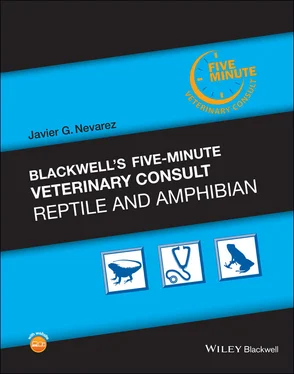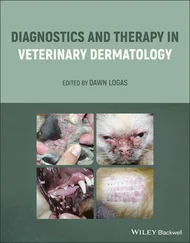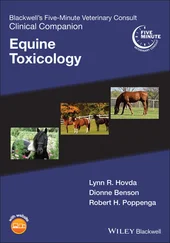EXPECTED COURSE AND PROGNOSIS
There is no specific treatment.
Disease progression is unknown as antemortem diagnosis is seldom determined.
Cases have ranged from acute to chronic protracted presentation of clinical signs.
Identifying adenovirus from a healthy animal is not diagnostic for a disease caused by the virus.
Reptiles can be inapparent hosts for adenoviruses.
 MISCELLANEOUS
MISCELLANEOUS
COMMENTS
N/A
N/A
N/A
AdV = Adenovirus
PCR = polymerase chain reaction
PCV = packed cell volume
TEM = transmission electron microscopy
Kik, MJL. Adenoviris infection in reptiles. Transmissible Diseases Handbook. 4th ed. European Association of Zoo and Wildlife Veterinarians. https://www.eazwv.org/page/inf_handbook
Jacobson E, Wellehan J, Stacy B. Reptile Adenovirus PCR and Sequencing at the University of Florida CVM. www.dachiu.com/beardeddragons/Adenovirus.pdf
1 Doszpoly A, Wellehan J.F.X. Jr., Childress AL, et al. Partial characterization of a new adenovirus lineage discovered in testudinoid turtles. Infect Genet Evol 2013; 17:106–112.
2 Papp T, Fledelius B, Schmidt V, et al. PCR‐sequence characterization of new adenoviruses found in reptiles and the first successful isolation of a lizard adenovirus. Vet Microbiol 2009; 134(3–4):233–240.
AuthorDrury R. Reavill, DVM, DABVP (Avian and Reptile & Amphibian Practice), DACVP
Anemia
 BASICS
BASICS
DEFINITION/OVERVIEW
Anemia is a sign of disease and is characterized by a decreased number of erythrocytes, hemoglobin deficiency or both. It can occur due to one of four main categories: decreased erythropoietic activity, hemorrhage, destruction of red blood cells, or sequestration.
Traumatic
Hemorrhagic
Maladaptation syndrome associated anemia: reported in stressed reptiles, associated with captivity or with capture of wild reptiles
Blood parasites
Virus associated anemia
Autoimmune hemolytic anemia: rare in reptiles
Wild‐caught reptiles or those housed under poor husbandry conditions may be more predisposed.
Nonspecific clinical signs including lethargy, anorexia, and behavioral changes.
Pallor of skin and mucus membrane color may also be observed.
Inadequate husbandry, including diet, is often a predisposing factor for many diseases of captive reptiles.
Any reptile maintained under poor husbandry conditions should be considered susceptible to disease.
Wild‐caught reptiles are more likely to have underlying diseases, especially endoparasites and hemoparasites, which may be the underlying cause of chronic anemia.
Any reptile with a chronic illness may be predisposed to anemia.
 DIAGNOSIS
DIAGNOSIS
DIFFERENTIAL DIAGNOSIS
Trauma leading to external or internal hemorrhage.
Maladaptation syndrome associated anemia—reported in stressed reptiles, associated with captivity or trapping of wild reptiles.
Hemoparasites
Malnutrition
Toxicity
Weakness and prostration due to metabolic bone disease, pregnancy, or infectious disease.
Blood sampling is essential for diagnosis and monitoring of anemic reptiles.
Patient’s size, condition, and venous access must all be considered.
Venipuncture sites with minimal lymphatic contamination are preferred, to obtain a more representative sample of the peripheral blood.
In chelonians, the jugular vein is the site with the least amount of lymphatic contamination.
Alternatively, the brachial plexus and coccygeal veins can be sampled.
The subcarapacial sinus tends to have the largest amount of lymphatic contamination.
In critically ill, possibly anemic, reptiles, aim to collect a blood volume of no more than 0.5% of the body weight (0.5 ml/100 g body weight) so as to not exacerbate the anemic condition.
EDTA can cause hemolysis and artifacts in most chelonian, so lithium heparin is the preferred anticoagulant.
Mucous membranes and general pallor—compared with mammals, reptiles’ mucous membranes are lighter in color but should still appear pink.
One exception is the family Chelydridae, which normally have rather pale mucous membranes.
Examination of the ocular conjunctiva and even the iris color in American box turtles (Terrapene sp.) has also been reported, associating the pale iris with low hematocrit and possible anemia.
Although there is limited ability to assess all the same hematologic parameters as in mammals, some basic guidelines can be found for certain values.
Normal values range from 20 to 45. Values below 20 suggest anemia in most cases.
A blood transfusion should be considered in animals with values below 10, although there is little research in reptilian blood transfusions.
Seasonal variations in this parameter should also be considered before making clinical decisions.
A low hematocrit with an increased polychromasia index is a normal physiologic change during brumation, but pathologic during the active season.
Normal values are 6–10 g/dl according to the species.
Lower values should suggest anemia. MCHC is calculated according to the hematocrit and hemoglobin, like MCH; these parameters show variation in case of anemia.
Individual variations should also be considered, as reptiles have different types of hemoglobin, which may influence the expression of clinical signs.
Polychromasia and Erythroblasts
An increased polychromasia and erythroblasts in general suggests an increased need for erythrocytes in peripheral blood and can be interpreted as evidence of a regenerative anemia.
Occasionally, a high number of erythroblasts may be found in the micro‐hematocrit tube, forming an intermediate layer between the buffy coat and the red blood concentrate.
This activity is usually accompanied by the presence of erythrocyte precursors in peripheral blood (erythroblasts, occasionally polychromatophils).
Hemoparasites may also lead to increased numbers of erythroblasts and polychromasia.
Polychromasia may also occur in the absence of anemia as has been reported in shedding reptiles.
When detected in peripheral blood as an anecdotal finding, it is not a manifestation of anemia.
Anemia should only be considered when mitoses appear in erythrocytes together with the presence of abundant erythroblasts and other markers described, such as altered hematocrit and irregular erythrocytic nucleus.
Читать дальше

 MISCELLANEOUS
MISCELLANEOUS BASICS
BASICS DIAGNOSIS
DIAGNOSIS










